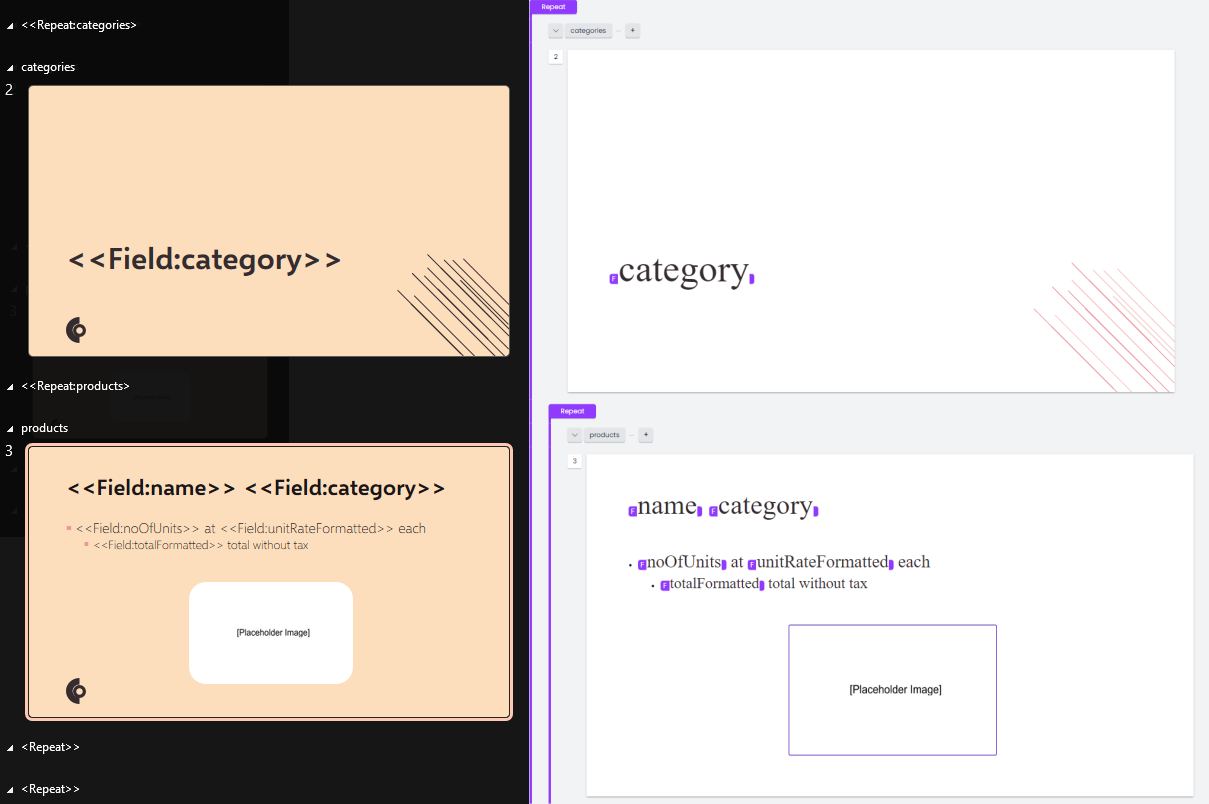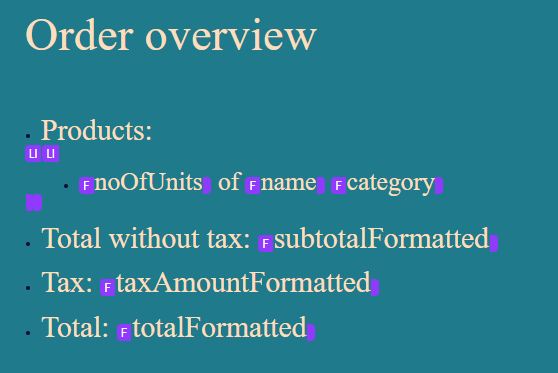Sales quotation (PowerPoint)
Create a pptx version of the sales quote
Introduction
This is a guide to creating a recipe for a presentation containing a sales quote similar to the one created in the Sales quotation guide. The aim of the guide is to illustrate the process of setting up a more complex PowerPoint recipe in Documotor.
What will I learn?
After following this guide, you'll be able to:
- Insert images into a PowerPoint template.
- Create a moderately complex PowerPoint recipe.
- Repeat a template slide, filling out different instances with different data points that share the same structure.
- Add bulleted and numbered lists to PowerPoint templates.
Prerequisites
You'll need access to a Documotor tenant, and it's assumed you've configured a PowerPoint template before and created the recipe for the Sales quotation in Word. The presentation we're creating here is the PowerPoint version of that one, but a bit simpler, since we'll omit some details and use the data that we already transformed there, rather than going through the transformation again.
Sample data and template
Here is the data that we'll use to populate the sample template:
{
"clientInfo": {
"contactPersons": [
"Jane Doe",
"John Doe"
],
"businessName": "Acme Corporation",
"addressLine1": "Main Street 1",
"addressLine2": "Anytown 10000, Ruritania"
},
"companyInfo": {
"contactPerson": "Jill Doe",
"businessName": "Contoso",
"addressLine1": "High Street 1",
"addressLine2": "Anycity 1000, Atlantis"
},
"companyWebsite": "http://www.example.com/",
"logo": "https://stsharedocumotor001.blob.core.windows.net/public-documentation/SalesQuote/logoipsum-216.png",
"currentDate": "November 20, 2023",
"VATRate": 0.25,
"categories": [
{
"category": "Chairs",
"products": [
{
"category": "chairs",
"SKU": 3,
"name": "Comfy",
"noOfUnits": "6",
"image": "https://stsharedocumotor001.blob.core.windows.net/public-documentation/SalesQuote/ComfyChair.jpeg",
"totalFormatted": "3.594,00 kr.",
"unitRateFormatted": "599,00 kr."
}
],
"subtotalFormatted": "3.594,00 kr.",
"taxAmountFormatted": "898,50 kr.",
"totalFormatted": "4.492,50 kr."
},
{
"category": "Sofas",
"products": [
{
"category": "sofas",
"SKU": 1,
"name": "Blue",
"noOfUnits": "3",
"image": "https://stsharedocumotor001.blob.core.windows.net/public-documentation/SalesQuote/BlueSofa.jpeg",
"totalFormatted": "8.997,00 kr.",
"unitRateFormatted": "2.999,00 kr."
},
{
"category": "sofas",
"SKU": 2,
"name": "Yellow",
"noOfUnits": "2",
"image": "https://stsharedocumotor001.blob.core.windows.net/public-documentation/SalesQuote/YellowSofa.jpeg",
"totalFormatted": "6.998,00 kr.",
"unitRateFormatted": "3.499,00 kr."
}
],
"subtotalFormatted": "15.995,00 kr.",
"taxAmountFormatted": "3.998,75 kr.",
"totalFormatted": "19.993,75 kr."
}
],
"subtotalFormatted": "19.589,00 kr.",
"taxAmountFormatted": "4.897,25 kr.",
"totalFormatted": "24.486,25 kr."
}Copy it, navigate to the Data view, and inside Sample Data, select the pen button to enter edit mode, then paste the data and update it by using the arrow button next to the pen.
Download the sample template, and then navigate to the Template view and upload it using the upload button in the right side of the Binding Editor toolbar. Notice that the template has 4 slides; this is how we'll refer to them:
- Title slide
- Category title slide
- Product info slide
- Summary slide
Remember to save your work as you go by pressing Ctrl+S or the Save button in the top-left.
Bindings
Most of the bindings here will be simple Field bindings that you're already familiar with. Therefore, we'll focus on repeating slides and lists, especially since this is the biggest difference between this document and the Sales quotation in Word. The process is quite similar to creating repeating tables in Word, though.
Repeat section
Looking at the resulting template, we see that we need to show a Category title slide followed by all the products from that category. Then, we go through the other categories and list the Product info slides for the products from each category. This is a similar structure to the repeated table from Sales quotation in Word, so we'll again use two Repeat bindings, one encompassing the other. However, here, entire slides need to be repeated, rather than portions of a document.
To insert bindings that affect entire slides or sections of slides, we need to enter selection mode from the Binding Editor toolbar.

The Selection mode toggle.
When in Selection mode, we can select slides that we want to insert the binding around. The outer Repeat binding should include the Category title slide, since there's one of those per category, and the Product info slide, since that one needs to be repeated once per each product per category. Then, we add the interior Repeat binding encompassing only the Product info slide.

The necessary bindings from PowerPoint and from the Binding editor.
Repeat content
In the Summary slide, all the products from all the categories are supposed to be listed in bullet points. One might try to do this with nested Repeat bindings, just like in Word, but in PowerPoint, the Repeat binding is restricted to section/slide repeats, while the standard text repeats are done using the List binding. Follow the example from the description of the list binding to create a bulleted list - note that we need to list all products from all categories, so you'll need to nest the list binding for the products array inside the list binding for the categories array.

The bindings in the last slide.
Fields
After inserting the correct Repeat and List bindings, inserting the Field bindings that remain is a breeze. The process is completely analogous to the one in Word, and you can consult the screenshots above to see which exact bindings need to be inserted and where.
Result
After you've inserted all the fields, the presentation should be complete. Remember to save your work and generate a document, which you can then compare with the target document to check if you built the recipe successfully. Additionally, here is what the template should look like after the bindings are added.
Updated 8 months ago